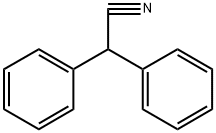Iminodiacetonitrile
- CAS NO.:628-87-5
- Empirical Formula: C4H5N3
- Molecular Weight: 95.1
- MDL number: MFCD00001887
- EINECS: 211-058-3
- SAFETY DATA SHEET (SDS)
- Update Date: 2024-12-18 14:15:30

What is Iminodiacetonitrile?
Chemical properties
tan to dark brown crystalline powder, crystals
The Uses of Iminodiacetonitrile
Iminodiacetonitrile is used as a chemical intermediate. It is also used in the preparation of iminodiacetic acid. Further, it is used to study the interference of nitriles in cyanide determination.
What are the applications of Application
Iminodiacetonitrile is used in the synthesis of iminodiacetic acid
Definition
ChEBI: A secondary amino compound that is ammonia in which two of the hydrogens are substituted by cyanomethyl groups.
Synthesis Reference(s)
The Journal of Organic Chemistry, 21, p. 1211, 1956 DOI: 10.1021/jo01117a002
Properties of Iminodiacetonitrile
| Melting point: | 69-71 °C(lit.) |
| Boiling point: | 167.6°C (rough estimate) |
| Density | 1.1031 (rough estimate) |
| refractive index | 1.5200 (estimate) |
| storage temp. | Keep in dark place,Sealed in dry,Room Temperature |
| form | powder to crystal |
| pka | -1.25±0.20(Predicted) |
| color | White to Almost white |
| Water Solubility | Soluble in water, acetone and hot methanol. |
| BRN | 773803 |
| CAS DataBase Reference | 628-87-5(CAS DataBase Reference) |
| NIST Chemistry Reference | Acetonitrile, iminodi(628-87-5) |
| EPA Substance Registry System | Acetonitrile, 2,2'-iminobis- (628-87-5) |
Safety information for Iminodiacetonitrile
| Signal word | Warning |
| Pictogram(s) |
 Skull and Crossbones Acute Toxicity GHS06  Exclamation Mark Irritant GHS07 |
| GHS Hazard Statements |
H301:Acute toxicity,oral H302:Acute toxicity,oral H315:Skin corrosion/irritation H319:Serious eye damage/eye irritation H335:Specific target organ toxicity, single exposure;Respiratory tract irritation |
| Precautionary Statement Codes |
P261:Avoid breathing dust/fume/gas/mist/vapours/spray. P264:Wash hands thoroughly after handling. P264:Wash skin thouroughly after handling. P270:Do not eat, drink or smoke when using this product. P280:Wear protective gloves/protective clothing/eye protection/face protection. P305+P351+P338:IF IN EYES: Rinse cautiously with water for several minutes. Remove contact lenses, if present and easy to do. Continuerinsing. P405:Store locked up. P501:Dispose of contents/container to..… |
Computed Descriptors for Iminodiacetonitrile
Iminodiacetonitrile manufacturer
New Products
Tetrabutylammonium hydrogen sulfate 2,2,6-Trimethyl-4H-1,3-dioxin-4-one 4-Piperidinopiperidine tert-Butyl acetoacetate 4-BROMOMETHYLTETRAHYDROPYRAN 3-Hydroxyazetidine hydrochloride Diallylamine, 99% Calcium hydroxide, 95% Aluminum oxide, basic 2-Bromophenylacetonitrile, 97% L-tert-Leucine,97% N-Hydroxy-2-methylpropanimidamide 4-(3,4-Dichlorophenyl)-3,4-Dihydro-N-Methyl-1-(2H)-Naphthalenimine (Schiff Base) 2-AMINO-3,5-DIBROMO BENZALDEHYDE [ADBA] L-Glutamic Acid Dimethyl Ester Hcl 10-Methoxy-5H-dibenz[b,f]azepine 5-Cyanophthalide N, N-Carbonyldiimidazole (CDI) 3-Methoxybenzonitrile 4-Methoxybenzonitrile Dibenzoyl Peroxide Titanium Dioxide Chloral PentachlorobenzonitrileRelated products of tetrahydrofuran








You may like
-
 Iminodiacetonitrile 95% CAS 628-87-5View Details
Iminodiacetonitrile 95% CAS 628-87-5View Details
628-87-5 -
 Iminodiacetonitrile CAS 628-87-5View Details
Iminodiacetonitrile CAS 628-87-5View Details
628-87-5 -
 Iminodiacetonitrile CAS 628-87-5View Details
Iminodiacetonitrile CAS 628-87-5View Details
628-87-5 -
 Ethyl-2-Chloroacetoacetate 609-15-4View Details
Ethyl-2-Chloroacetoacetate 609-15-4View Details
609-15-4 -
 CIS- BROMO BENZOATEView Details
CIS- BROMO BENZOATEView Details
61397-56-6 -
 609-15-4View Details
609-15-4View Details
609-15-4 -
![1-(6-Methylpyridin-3-Yl)-2-[4-(Methylsulfonyl)Phenyl]Ethanone [Ketosulfone] 99%](https://img.chemicalbook.in//Content/image/CP5.jpg) 1-(6-Methylpyridin-3-Yl)-2-[4-(Methylsulfonyl)Phenyl]Ethanone [Ketosulfone] 99%View Details
1-(6-Methylpyridin-3-Yl)-2-[4-(Methylsulfonyl)Phenyl]Ethanone [Ketosulfone] 99%View Details
221615-75-4 -
 27143-07-3View Details
27143-07-3View Details
27143-07-3
Statement: All products displayed on this website are only used for non medical purposes such as industrial applications or scientific research, and cannot be used for clinical diagnosis or treatment of humans or animals. They are not medicinal or edible.
